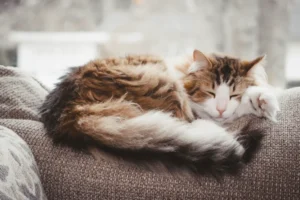Cats are known for their diverse vocalizations, from sweet meows to loud yowls. But have you ever noticed that your cat’s voice can change on occasion? Understanding why cats change their voice can provide valuable insights into their behavior and communication patterns.
Cats change their voice for a variety of reasons, including illness, stress, and age-related issues. By observing and analyzing these changes, you can better understand your feline companion and address any underlying issues that may be causing these vocal fluctuations.
Illness or Pain
Cats are known to be masters of hiding their discomfort, but one way they may communicate their distress is through changes in their voice. If your feline friend suddenly sounds different, it could be a sign of illness or pain. Cats are notoriously stoic creatures, so any deviation from their normal meows and purrs should prompt a closer look.
When a cat is feeling under the weather or experiencing pain, they may exhibit alterations in their vocalizations. For example, a normally chatty cat may become unusually quiet, while a typically quiet cat may start meowing more frequently or loudly. This change in vocal pattern is their way of alerting their human companions that something is amiss and they need help.
If you notice a sudden shift in your cat’s voice, it’s essential to pay attention and monitor their behavior closely. Consult a veterinarian to rule out any underlying health issues that could be causing discomfort. Remember, your furry friend relies on you to advocate for their well-being, so don’t ignore any changes in their vocalizations.
Stress or Anxiety
Just like humans, cats can experience stress and anxiety that manifest in various ways, including changes in their voice. If your usually talkative cat suddenly goes silent or starts yowling more than usual, stress could be the culprit. Cats are sensitive creatures that can be easily affected by changes in their environment or routine.
Stressors like moving to a new home, introducing new pets, or changes in their daily schedule can trigger anxiety in cats, leading to alterations in their vocalizations. Some cats may become more vocal as a coping mechanism, while others may withdraw and limit their meows.
It’s important to create a safe and comfortable environment for your cat to help alleviate their stress. Providing hiding spots, interactive toys, and a consistent routine can help reduce anxiety levels. If your cat’s voice changes persist despite your best efforts, consider consulting with a veterinarian or a feline behavior specialist for further guidance.
Additional Insight: Cats may also change their voice as a form of attention-seeking behavior. If they feel ignored or neglected, they may resort to meowing more frequently or loudly to grab your attention. Spending quality time with your cat and engaging in interactive play sessions can help fulfill their social and emotional needs, potentially reducing excessive vocalizations.
Age-Related Changes
As cats age, just like humans, their vocal cords can undergo changes that affect the sound of their voice. Aging can cause the vocal cords to lose elasticity, resulting in a higher-pitched or weaker voice. If you notice your elderly cat’s voice sounding different, it could be a natural part of the aging process. To ensure your cat’s well-being, it’s always a good idea to consult with your veterinarian to rule out any underlying health issues that could be contributing to the change in their voice.
Behavioral Reasons
Sometimes, cats change their voice due to behavioral reasons rather than physical ones. For example, a cat seeking attention may meow loudly and persistently, while a cat feeling territorial may growl or hiss more frequently. Understanding the behavior behind the vocal change can help you address the root cause. If your cat’s vocalization seems out of character, consider their surroundings and recent changes. Providing toys, scratching posts, or enriching their environment can also help satisfy behavioral needs and reduce excessive vocalization.
Attention-seeking Behavior : Cats may change their voice to grab your attention. They may meow more loudly or frequently if they feel neglected or desire interaction.
Stress or Anxiety : Cats can change their voice in response to stress or anxiety. They may meow differently when feeling anxious or overwhelmed.
Medical Issues : In some cases, a change in a cat’s vocalization could be a sign of an underlying medical condition. If you notice a drastic change in your cat’s voice, it’s crucial to consult with your veterinarian for a thorough examination.
Remember, every cat is unique, and by understanding the possible reasons for their vocal changes, you can better support their well-being and strengthen your bond with your feline friend.
Environmental Factors
Have you ever noticed your cat’s meow sounding different after a big change in their environment? Cats are known to change their vocalizations in response to environmental factors. Moving to a new home, introducing a new pet, or even changes in their daily routine can all trigger shifts in your cat’s voice.
When a cat faces a new environment, it can lead to stress or anxiety, causing them to vocalize differently. They might meow more frequently, at a higher pitch, or even produce new types of sounds altogether. It’s their way of expressing their emotions and adapting to the changes around them.
If you notice your cat’s voice changing, try to provide them with a comfortable and familiar space to help them adjust. Keep their routine consistent and offer plenty of love and reassurance during this transition period. Remember, your furry friend might just need some time to settle in and find their voice again.
Trivia: Unique Cat Sounds
Did you know that cats have a wide range of unique sounds beyond the classic meow? From chirps and trills to yowls and purrs, our feline friends have a diverse vocal repertoire that can vary based on their mood and intentions.
Chirps : Cats often use short, high-pitched chirps to communicate with their owners or other cats. It’s a friendly and inviting sound that’s commonly heard during playtime or when they’re seeking attention.
Yowls : These long, intense meows can indicate that your cat is feeling stressed, lonely, or in pain. It’s their way of expressing strong emotions and seeking comfort.
Purring : While purring is a well-known sound, not everyone knows that cats can purr in different situations. They might purr when they’re content, nervous, or even in pain, using it as a form of self-soothing.
By understanding these unique sounds, you can better interpret your cat’s vocalizations and respond to their needs effectively. Pay attention to the context in which they vocalize and consider how you can best support them based on their specific sounds.
Tips for Monitoring Voice Changes
It’s essential to pay attention to your feline friend’s voice as it can be a key indicator of their health and well-being. Here are some tips to help you monitor any changes in your cat’s voice:
Regular Observation : Take note of your cat’s usual vocalizations and pitch. Any sudden changes in volume, tone, or frequency could signal a potential issue.
Seek Veterinary Attention : If you notice persistent hoarseness, wheezing, or any other significant alterations in your cat’s voice, it’s crucial to schedule a visit with your veterinarian promptly.
Observe Behavior : Alongside vocal changes, monitor your cat’s overall behavior for any signs of discomfort or distress. Changes in vocalizations paired with abnormal behavior could indicate a health problem.
Keep Track : Maintain a log of any voice changes, including when they occur and any accompanying symptoms. This record can assist your vet in diagnosing any underlying issues more efficiently.
Consult a Professional : If you’re unsure about the significance of your cat’s voice changes, don’t hesitate to seek professional advice. Veterinarians are trained to recognize subtle signs that may not be apparent to the untrained eye.
By staying vigilant and proactive in monitoring your cat’s voice, you can catch any potential health concerns early and ensure your feline companion stays happy and healthy.
Conclusion: Understanding Your Feline Friend
Your cat’s voice is a valuable form of communication, allowing them to express their needs, emotions, and health status. By familiarizing yourself with your cat’s typical vocal patterns and being alert to any changes, you can better understand their well-being. Remember, a cat’s voice can vary for reasons such as age, breed, or specific situations, but significant or persistent changes should never be ignored. Always prioritize your cat’s health and seek veterinary attention if you have concerns about their voice. By being attuned to your feline friend’s vocalizations, you can strengthen your bond and ensure their voice remains a happy and healthy one.
Alex, a passionate animal lover, has experience in training and understanding animal behavior. As a proud pet parent to two dogs and three cats, he founded AnimalReport.net to share insights from animal experts and expand his knowledge of the animal kingdom.









